The Microsoft Surface Laptop 4 15-Inch Review: Refreshing Ryzen
by Brett Howse on May 6, 2021 8:00 AM ESTDisplay Analysis
One area where Microsoft has really focused on is displays, basically since the Surface Pro 4 and Surface Book launched back in 2016. Since that time, they are one of the very few manufacturers to hardware calibrate every display at the factory. Microsoft has also embraced the 3:2 aspect ratio across the entire Surface lineup, from the diminutive Surface Go, all the way up to the 28.5-inch Surface Studio. On notebook computers, the extra height offered by the taller screen provides a better workflow for most tasks, although it does increase the letterboxing for viewing media that is delivered in 16:9.
 Surface Laptop 4 Subpixel Arrangement
Surface Laptop 4 Subpixel Arrangement
Although there have been some devices pushing display technology more quickly than Microsoft, it is not always for the benefit of all users all the time. Microsoft has stuck with sRGB gamut displays, when many competitors offer displays with the wider gamut P3-D65 support, or Adobe RGB. Some displays offer Dolby Vision, and some offer HDR, but sadly, none of those technologies make PC displays better all the time.
As I have discussed many times in the past, Windows 10 lacks proper color management support for the entire display pipeline, and as such, moving away from the expected sRGB color gamut on the PC is a challenge, and can result in many unwanted repercussions. Applications must explicitly support wide-gamut color, and since most do not, the experience is less than ideal. While it would be nice for the Surface team to address this, to this point, they have not. So, for today, sRGB is the best choice for most of the people, most of the time.
The 3:2 display on the Surface Laptop 4 offers a resolution of 2496x1664 pixels, which works out to 201 pixels per inch. It can’t match the 260 pixels per inch of the much more expensive Surface Book, but the display density is a nice compromise between clarity, cost, and performance. Microsoft also includes two color profiles, with sRGB, and Enhanced, which tweaks the colors to be a bit more vivid, although at the cost of accuracy. Most people will likely prefer this option though.
To test the display characteristics, we use Portrait Displays Calman software with a custom workflow. For brightness and contrast measurements, we use the X-Rite i1Display Pro colorimeter, and for color accuracy testing, we use the X-Rite i1 Pro2 spectrophotometer.
Brightness and Contrast
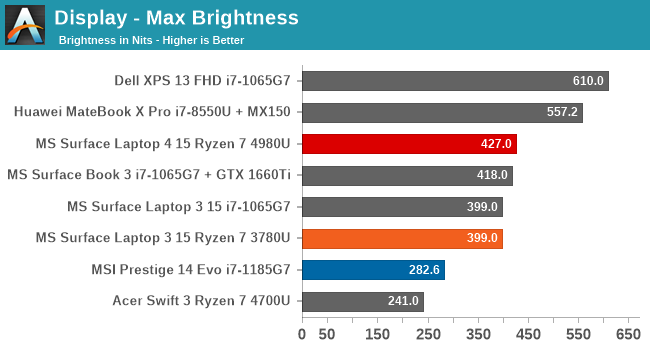
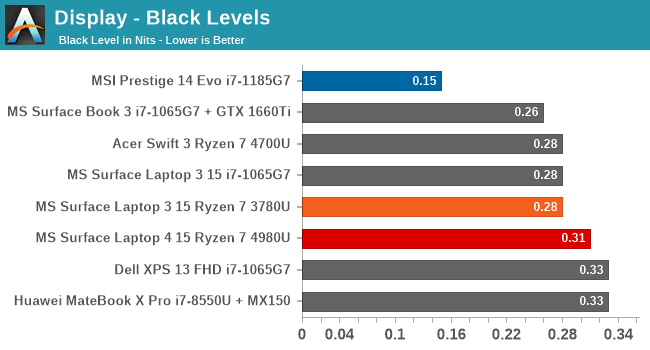
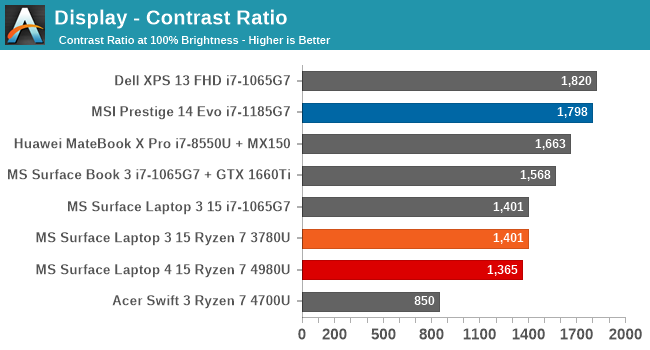
At 427 nits, the Surface Laptop 4 gets quite bright, although it is nowhere near the Dell XPS 13, and the Dell also has one of the best anti-reflective coatings in the PC space, making it a superior device for outdoor use. But there is still plenty of brightness for most use cases. Black levels are good, but the overall contrast ratio can not match the best displays on the market, which is a shame. The display goes all the way down to 6.7 nits, so the brightness range is quite wide.
Grayscale
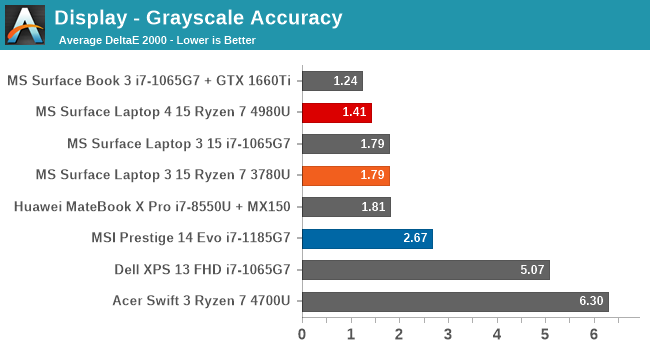
With years of experience calibrating every display panel they offer; it is no surprise to see the Surface Laptop 4 results having excellent accuracy. Grayscale is one area that can be tightened up with a custom ICC profile, but it is really not needed when purchasing a Surface device, as they are all good out of the box.
Gamut Accuracy

Color accuracy at the 100% levels for the primary and secondary colors is spot on with this device.
Saturation
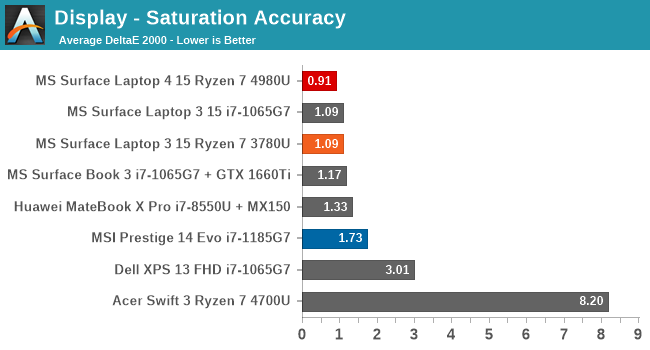
Unlike the Gamut test where the primary and secondary colors are tested at the 100% levels, the saturation test increases the test points to 4-bit steps from 0-100%. Again, the Surface Laptop 4 is superb here.
Gretag Macbeth
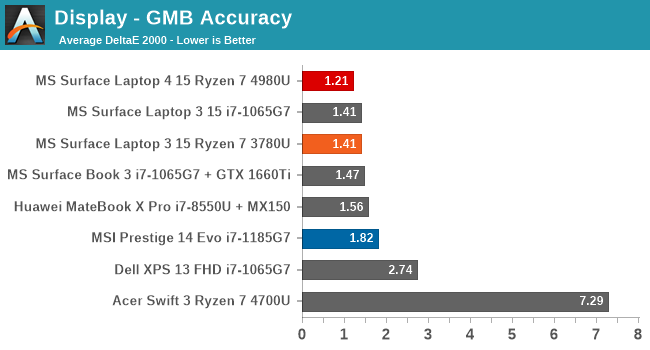
The final test moves away from just testing the primary and secondary color axis, and tests colors from across the spectrum, including the important skin tones. The results are excellent, again. No single color even hits the 3.0 error level.
Colorchecker
The final image is the relative colorchecker, where the target color is on the bottom of the swatch, and the displayed color is on the top. The error levels are almost imperceptible to the human eye, and showcases the reason why factory calibrating the display is so valuable.
Display Conclusion
Although the Surface Laptop 4 does not offer the current display buzzwords of HDR, Dolby Vision, or DCI-P3 gamut (which is technically an incorrect term on the PC, but does not stop the marketing departments from using it) the Surface Laptop 4, as usual with a Surface device, delivers some of the most accurate colors of any device out of the box.
If you want a device to edit photos or videos, having an accurate display can be critical to your workflow, and this is where the Surface lineup really shines. With every generation, and every price point, every Surface device offers a very solid display, and is one of the best reasons to consider one. The 3:2 aspect ratio is also a win for productivity tasks, especially compared to 16:9 devices.


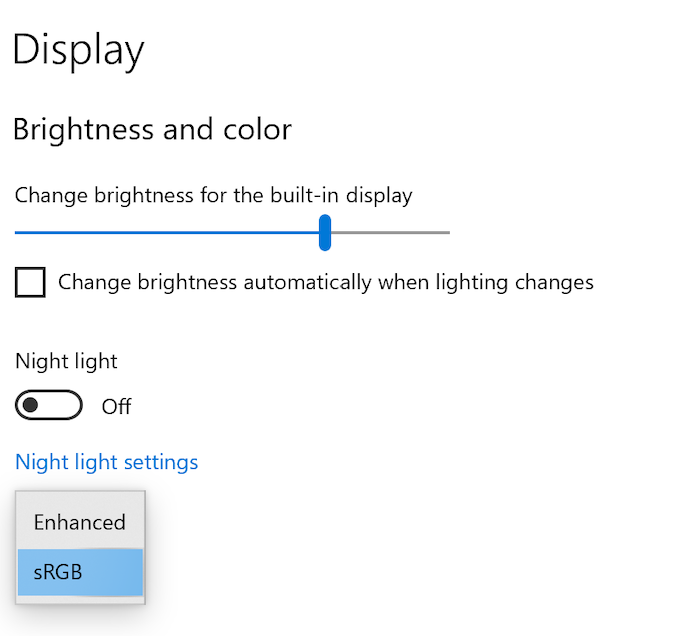













98 Comments
View All Comments
Eletriarnation - Thursday, May 6, 2021 - link
It really is. You don't actually need any at all, this little company called Apple was the first to figure it out.hanselltc - Thursday, May 6, 2021 - link
They've also figured out how to make touchpads that makes everything else feel like compressed trash dug up from an abandoned landfill, so there's that.Gam3r01 - Thursday, May 6, 2021 - link
Having purchased a 2nd hand Surface Laptop 3 last week, in my experience one USB-A was limiting. I do not own a single USB-C device and re-installing Windows and installing Linux from a USB stick without the use of the built-in keyboard and trackpad was annoying. As was backing up the system with a USB bootable recovery program (that also lacked the wifi driver).To install Windows, rather than use the latest image, I resorted to the official MS SL3 recovery USB, which included the drivers during setup, but incurred hours of Windows updates. For Linux I used the Grub ‘toram’ option and fumbled with swapping keyboard and mouse in and out of the single port, as well as using the onscreen accessibility keyboard. Then for a backup/recovery (lacking input drivers and a wifi driver), I repartitioned the drive and backed up to a spare partition.
Easy when you know how, but it was frustrating, especially as I sold by only USB hub (built into a monitor) last month.
Be Safe, peace.
Alistair - Thursday, May 6, 2021 - link
Well said, that's an example of the kind of problem I've had also.Dug - Thursday, May 6, 2021 - link
So what you are saying, is you didn't prepare. You used the wrong software, and you don't have a usb hub that 99% of the population has.Holliday75 - Monday, May 10, 2021 - link
He also explained a situation in which 99% of computer users would not even understand let alone run into. Been in IT 20+ years and rarely have to work like that. If vendors considered these things they would probably be throwing away millions in profit.dontlistentome - Friday, May 7, 2021 - link
That's why Apple give you none.This is a premium device. People who can afford it buy a bluetooth mouse or a mouse with a usb C dongle.
I've had thinkpad laptops with thunderbolt for 4 years now. I use a TB3 dock at home and work, have usbc charging cables for my Android and ipad and have multiple usb drives that have dual a/c connectors. Heck, my car is all USB-C now for Android auto.
Linustechtips12#6900xt - Friday, May 7, 2021 - link
I have an HP x360 2in1 with a ryzen 4700u and 8GB of ram that I will upgrade to 16-32GB here soon but besides the point, it has a power dc jack, USB-c with HDMI, DisplayPort, power and data transfer, an HDMI port and a headphone jack, ohh and an sd card slot that I basically never use but anyway I dock it with a USB-C hub and a monitor over HDMI all connected to a usb-c hub that I have with 3 USB 3.0 and 1 HDMI and another sd card slot, I plug into power using the dc power jack and im set to go with 2 cables to plug in. point is, on the go I maybe use a wired mouse if I game, but most of the time I use a USB port for data transfer and that about it, 1 USB port with a USB-c and another power jack is honestly perfect for me at least.ballsystemlord - Tuesday, May 11, 2021 - link
I agree. We need at least 2 USB-A ports.eastcoast_pete - Thursday, May 6, 2021 - link
Thanks Brett! Agree on most of your points. Questions, comments: Is the memory user upgradable? It doesn't seem to be, which would be a major minus for a "premium" laptop. Other Comment: Regarding your Handbrake tests, I would stay away from the "Hardware" ones unless you can add information on the size of the resulting file and the quality. One aspect where NVIDIA is (still?) far ahead of AMD's GPUs is the encoding ASIC; since Turing, NVENC has become downright usable (comparable quality to software encoding at about 1.2 x the file size, much faster) whereas AMD's solution is clearly inferior in quality. If that has changed in recent months, I'd love to know.Lastly, I didn't like AMD replacing the number of iGPU cores with cranking up the frequency (from previous Ryzen APUs), and it's now biting them in the rear. An 10- 11 core design like the older gen would have beaten Xe.